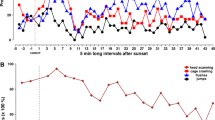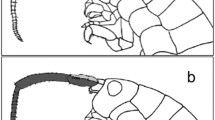Summary
Several species of night migrating birds, especially North American emberizines, exhibit markedly different orientation behaviour when tested in circular cages under clear skies at dusk as compared with tests performed after complete darkness. During the period between sunset and the first appearance of stars, birds tend to show high levels of well-oriented hopping; birds deprived of exposure to clear skies at dusk hop less and their activity is usually not oriented. There is evidence that visual cues available during the dusk period, but not later, are responsible for this difference, but details of the orientation mechanisms involved are unclear. We performed 3-h fast and slow clock shifts on white-throated sparrows (Zonotrichia albicollis) to address two questions concerning migratory orientation at dusk: (1) Is the better orientation of sparrows tested at dusk a function of the visual cues available at that time, or does it result from circadian changes in motivation?; and (2) Is the dusk orientation based on a time-compensated sun compass?
Sparrows subjected to a 3-h slow clock shift were tested with controls on clear, moonless nights beginning immediately after lights-off in the clock shift room and thus about 3.5 h after local sunset. Individuals of both groups performed poorly oriented hopping typical of tests performed after complete darkness. The pooled data from each group were not significantly oriented. These results show that the visual cues available shortly after sunset, not temporal changes in the motivation of the birds, are responsible for the qualitative differences in orientation.
Birds exposed to a 3-h fast clock shift were tested with controls on clear evenings between sunset and the first appearance of stars. Both groups showed well-oriented hopping. The mean direction of the pooled tests of controls was 325°, a typical spring orientation direction for this species. The mean direction of the pooled tests of the clock shifted birds (274°) was significantly different from that of controls and the 51° counterclockwise shift is consistent with that predicted by a time-compensated sun compass model.
Similar content being viewed by others
References
Able KP (1982) Skylight polarization patterns at dusk influence the migratory orientation of birds. Nature 299:550–551
Able KP, Bingman VP (1986) The development of orientation and navigation behavior in birds. Q Rev Biol (in press)
Able KP, Cherry JD (1986) Laboratory and field studies of avian migratory orientation. In: Rankin MA (ed) Migration: mechanisms and adaptive significance. Univ Texas Press, Austin (in press)
Able KP, Dillon PM (1977) Sun compass orientation in a nocturnal migrant, the white-throated sparrow. Condor 79:393–395
Batschelet E (1981) Circular statistics in biology. Academic Press, London
Bingman VP (1983) Importance of earth's magnetism for the sunset orientation of migratory naive savannah sparrows. Monit Zool Ital (NS) 17:395–400
Cherry JD (1984) Migratory orientation of tree sparrows. MS thesis, State Univ New York at Albany
Cherry JD, Able KP (1986) An alternative method for the analysis of Emlen funnel data. Auk 103:225–227
Emlen ST (1970) Celestial rotation: its importance in the development of migratory orientation. Science 170:1198–1201
Emlen ST (1980) Decision making by nocturnal bird migrants: the integration of multiple cues. In: Nohring R (ed) Acta XVII Congr Intern Ornithol. Deutsche Ornithol-Ges, Berlin, pp 553–560
Emlen ST, Emlen JT (1966) A technique for recording migratory orientation of captive birds. Auk 83:361–367
Gauthreaux SA (1971) A radar and direct visual study of passerine spring migration in southern Louisiana. Auk 88:343–365
Gould JL (1980) Sun compensation by bees. Science 207:545–547
Hebrard JJ (1971) The nightly initiation of passerine migration in spring: a direct visual study. Ibis 113:8–18
Katz YB (1980) [The role of the sun in the migratory orientation of the European robin, a nocturnal migrant.] PhD dissertation, Akad Nauk Latvian SSR, Riga (in Russian)
Katz YB (1982) Do night migrants use the sun for orientation? In: Ilyichev VD, Gavrilov VM (eds) Abstracts of symposia and poster presentations, XVIII Congr Intern Ornithol. Nauka, Moscow
Katz YB (1985) Sunset and the orientation of European robins (Erithacus rubecula). Anim Behav 33:825–828
Liepa V (1978) [Orientation of European robin in circular cages under artificial light clues]. In: Mihelsons H (ed) [Orientation of birds.] Zinatne, Riga, pp 77–179 (in Russian)
Liepa V (1982) Testing the significance of internal clock in the night orientation of the robin (Erithacus rubecula L.) under natural sky. In: Ilyichev VD, Gavrilov VM (eds) Abstracts of symposia and poster presentations, XVIII Congr Intern Ornithol. Nauka, Moscow
Matthews GVT (1968) Bird navigation. Cambridge Univ Press, London
McMillan JP, Gauthreaux SA, Helms CW (1970) Spring migratory restlessness in caged birds: a circadian rhythm. Biol Science 20:1259–1260
Moore FR (1978) Sunset and the orientation of a nocturnal migrant bird. Nature 74:154–156
Moore FR (1980) Solar cues in the migratory orientation of the savannah sparrow,Passerculus sandwichensis. Anim Behav 28:684–704
Moore FR (1982) Sunset and the orientation of a nocturnal bird migrant: a mirror experiment. Behav Ecol Sociobiol 10:153–155
Moore FR (1985) Integration of environmental stimuli in the migratory orientation of the savannah sparrow (Passerculus sandwichensis). Anim Behav 33:657–663
Palmgren P (1944) Studien über die Tagesrhythmik gekäfigter Zugvögel. Z Tierpsychol 6:44–86
Parslow JLF (1969) The migration of passerine night migrants across the English Channel studied by radar. Ibis 111:48–79
Richardson WJ (1970) Temporal variations in the volume of bird migration: a radar study in Canada. Proc World Conf Bird Hazards to Aircraft, Kingston, Ont, pp 323–334
Saint Paul U von (1953) Nachweis der Sonnenorientierung bei nächtlich ziehenden Vögeln. Behaviour 6:1–7
Schmidt-Koenig K (1961) Die Sonnenorientierung richtungsdressierter Tauben in ihrer physiologischen Nacht. Naturwissenschaften 48:110
Schmidt-Koenig K (1963) Sun compass orientation of pigeons upon displacement north of the Arctic Circle. Biol Bull 127:154–158
Vilks I, Katz YB, Liepa V (1982) The role of artificial light sources for the visual orientation of European robins (Erithacus rubecula). In: Ilyichev VD, Gavrilov VM (eds) Abstracts of symposia and poster presentations, XVIII Congr Intern Ornithol. Nauka, Moscow, pp 16–17
Vleugel DA (1954) Waarnemingen over de nachttrek van lijsters (Turdus) en hun waarschijnlikje Orientierung. Limosa 27:1–19
Wiltschko R (1983) The ontogeny of orientation in young homing pigeons. Comp Biochem Physiol 76A:701–708
Wiltschko W (1982) The migratory orientation of garden warblers,Sylvia borin. In: Papi F, Wallraff HG (eds) Avian navigation. Springer, Berlin Heidelberg New York, pp 50–58
Wiltschko W (1983) Compasses used by birds. Comp Biochem Physiol 76A:709–717
Wiltschko W, Wiltschko R (1975a) The interaction of stars and magnetic field in the orientation system of night migrating birds. Part I. Autumn experiments with European warblers (Gen. Sylvia). Z Tierpsychol 37:337–355
Wiltschko W, Wiltschko R (1975b) The interaction of stars and magnetic field in the orientation system of night migrating birds. Part II. Spring experiments with European robins (Erithacus rubecula). Z Tierpsychol 39:265–282
Wiltschko W, Wiltschko R, Keeton WT, Madden R (1983) Growing up in an altered magnetic field affects the initial orientation of young homing pigeons. Behav Ecol Sociobiol 12:135–142
Author information
Authors and Affiliations
Rights and permissions
About this article
Cite this article
Able, K.P., Cherry, J.D. Mechanisms of dusk orientation in white-throated sparrows (Zonotrichia albicollis): Clock-shift experiments. J. Comp. Physiol. 159, 107–113 (1986). https://doi.org/10.1007/BF00612501
Received:
Issue Date:
DOI: https://doi.org/10.1007/BF00612501




